Yoga practices provide effective solutions for stress relief, improved flexibility, and enhanced mental clarity. Techniques such as deep breathing and mindfulness reduce stress and promote relaxation. Various styles, including Hatha and Vinyasa, cater to individual needs while improving physical performance. Regular practice fosters a deeper connection between mind and body, leading to overall well-being.
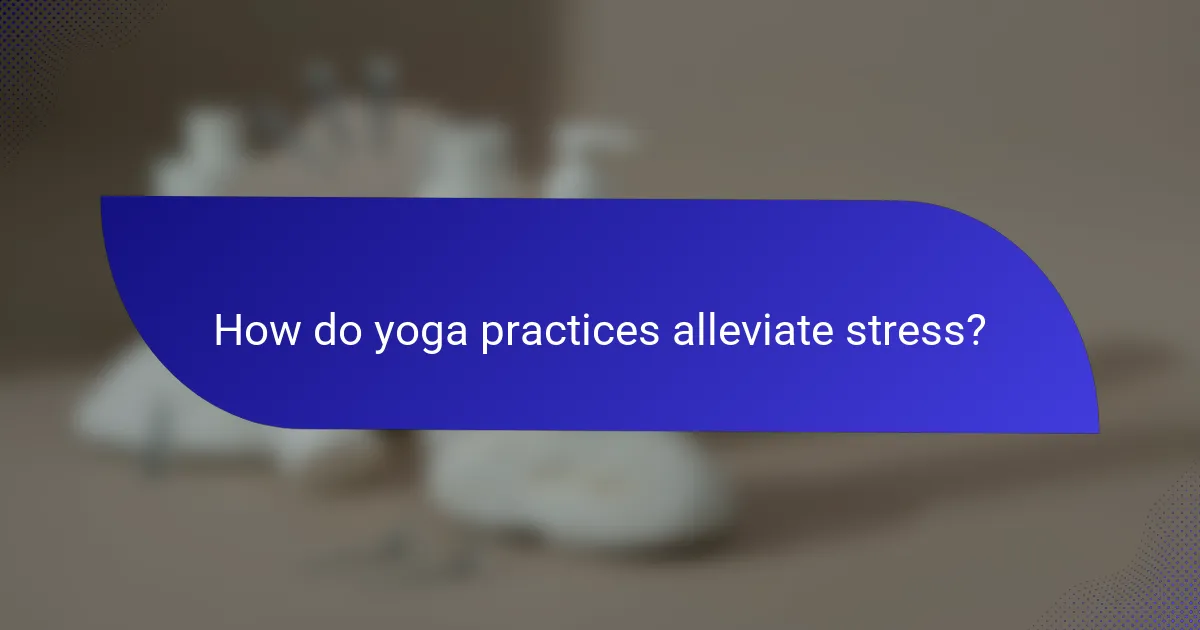
How do yoga practices alleviate stress?
Yoga practices effectively alleviate stress by promoting relaxation, enhancing mental clarity, and improving flexibility. Techniques such as deep breathing, mindfulness, and physical postures help reduce cortisol levels, leading to a calmer state of mind. Regular practice can enhance emotional resilience and foster a sense of well-being. For example, studies show that participants who engaged in yoga reported lower stress levels and improved mood. This holistic approach addresses both physical and mental aspects, making it a powerful tool for stress management.
What specific techniques are effective for stress relief?
Yoga practices such as Hatha, Vinyasa, and restorative yoga are effective for stress relief. These techniques promote relaxation, enhance flexibility, and improve mental clarity. Hatha yoga focuses on gentle postures and breathing, which reduces tension. Vinyasa offers a dynamic flow that encourages mindfulness and reduces anxiety. Restorative yoga uses props to support the body, fostering deep relaxation and emotional release. Regular practice can lower cortisol levels, leading to improved overall well-being.
Which breathing exercises enhance relaxation during yoga?
Breathing exercises such as diaphragmatic breathing, alternate nostril breathing, and box breathing enhance relaxation during yoga. These techniques promote deep breathing, reduce stress, and improve mental clarity. Diaphragmatic breathing engages the diaphragm fully, allowing for maximum oxygen intake. Alternate nostril breathing balances the body’s energy and calms the mind. Box breathing, characterized by equal inhalation, retention, exhalation, and pause, fosters focus and tranquility. Incorporating these practices into yoga sessions can significantly enhance the overall experience.
How does mindfulness in yoga contribute to stress reduction?
Mindfulness in yoga significantly reduces stress by promoting relaxation and enhancing mental clarity. Through focused breathing and meditation, practitioners cultivate awareness and presence, which decreases anxiety levels. Studies indicate that regular yoga practice can lower cortisol, the stress hormone, contributing to overall well-being. Additionally, mindfulness encourages a deeper connection to the body, fostering resilience against stressors.
What role does the physical environment play in stress relief through yoga?
The physical environment significantly enhances stress relief during yoga by promoting relaxation and focus. Elements like natural light, soothing colours, and calming sounds create a serene atmosphere. Studies show that practicing yoga in tranquil spaces reduces anxiety levels and improves mental clarity. Additionally, outdoor settings can increase feelings of connection to nature, further amplifying the stress-relieving effects of yoga.

What are the key benefits of yoga for flexibility?
Yoga significantly enhances flexibility through various poses and practices. Regular yoga sessions stretch and strengthen muscles, improving overall range of motion. This practice promotes increased blood flow to joints and muscles, which aids recovery and reduces stiffness. Additionally, yoga fosters body awareness, helping individuals identify and address areas of tightness. As a result, practitioners often experience improved posture and balance, contributing to better physical performance in daily activities.
How does regular yoga practice improve overall flexibility?
Regular yoga practice significantly enhances overall flexibility by promoting muscle elongation and joint mobility. Consistent stretching during yoga sessions facilitates the gradual improvement of range of motion. As a result, practitioners often experience reduced stiffness and increased ease of movement. Additionally, specific poses target various muscle groups, contributing to balanced flexibility throughout the body. This holistic approach not only benefits physical performance but also supports mental clarity and stress relief, making yoga a comprehensive practice for overall well-being.
Which yoga poses are particularly beneficial for enhancing flexibility?
The most beneficial yoga poses for enhancing flexibility include Downward-Facing Dog, Forward Bend, and Pigeon Pose. These poses effectively stretch and strengthen various muscle groups, promoting greater range of motion.
Downward-Facing Dog stretches the hamstrings, calves, and spine. Forward Bend targets the lower back and hamstrings, aiding in relaxation. Pigeon Pose opens the hips, improving mobility.
Incorporating these poses into a routine can lead to increased flexibility and overall physical well-being. Regular practice fosters not only physical benefits but also mental clarity and stress relief.
What is the connection between flexibility and injury prevention in yoga?
Flexibility in yoga significantly contributes to injury prevention by enhancing joint mobility and muscle elasticity. Improved flexibility allows for better alignment and balance during poses, reducing strain on muscles and connective tissues. As a result, practitioners experience fewer injuries, particularly in high-stress areas like the lower back and knees. Regular yoga practice fosters these benefits over time, making it an effective tool for maintaining physical health and preventing injuries.
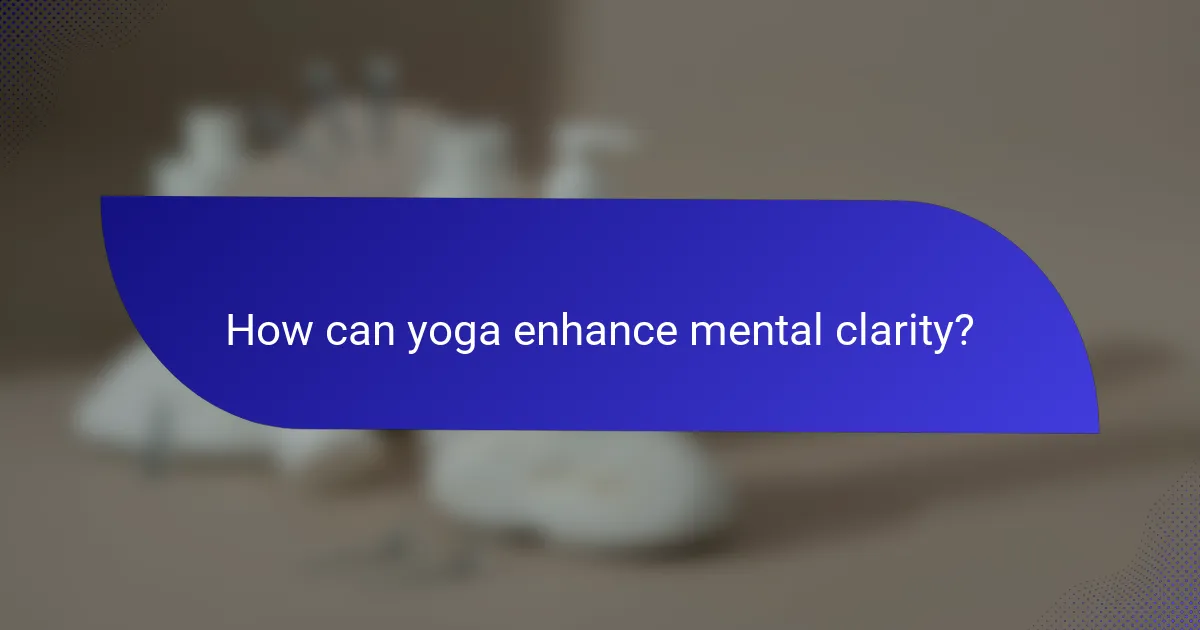
How can yoga enhance mental clarity?
Yoga enhances mental clarity through focused breathing, mindfulness, and physical postures. These practices reduce stress, improve concentration, and promote a calm mind. Regular yoga sessions can lead to increased cognitive function and emotional stability, contributing to overall mental clarity. Engaging in yoga can also help in developing a deeper connection between mind and body, fostering a more centered and clear thought process.
What mental exercises complement yoga practices for clarity?
Mental exercises that enhance yoga practices for clarity include mindfulness meditation, breath control techniques, visualization, and journaling. These practices improve focus and promote mental clarity, complementing the benefits of yoga for stress relief and flexibility. Mindfulness meditation fosters present-moment awareness, while breath control techniques help regulate stress responses. Visualization encourages positive thinking, and journaling aids in processing thoughts and emotions. Integrating these exercises can deepen the overall impact of yoga practices on mental well-being.
How does yoga influence cognitive function and focus?
Yoga enhances cognitive function and focus by reducing stress and promoting mental clarity. Regular practice increases blood flow to the brain, which can improve memory and concentration. Mindfulness techniques in yoga, such as breath control and meditation, help sharpen attention and foster a calm mental state. Studies indicate that participants in yoga programs often report improved cognitive performance and reduced anxiety levels, which contribute to better focus. Incorporating yoga into daily routines can lead to significant benefits for mental health and cognitive abilities.
Which meditation techniques within yoga boost mental clarity?
Meditation techniques within yoga that boost mental clarity include mindfulness meditation, breath awareness, and mantra meditation. These practices enhance focus and reduce mental clutter.
Mindfulness meditation encourages present-moment awareness, fostering clarity by reducing distractions. Breath awareness focuses on the breath, promoting calmness and concentration. Mantra meditation involves repeating a word or phrase, which helps center the mind and improve mental clarity.
Incorporating these techniques into your yoga routine can significantly enhance mental clarity and overall well-being.
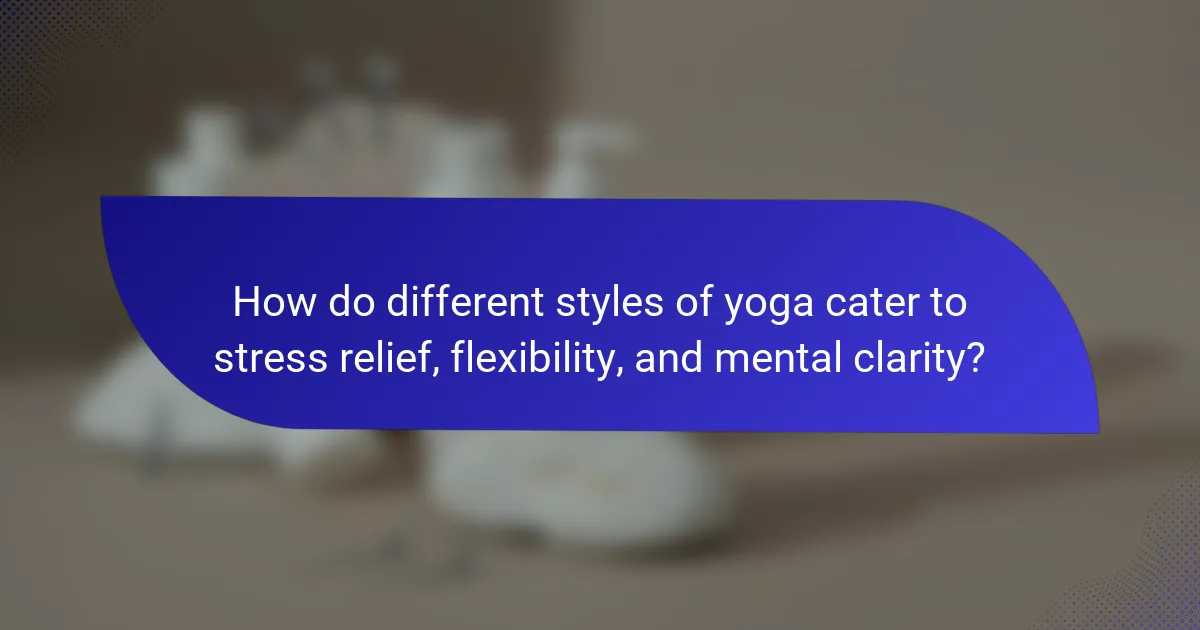
How do different styles of yoga cater to stress relief, flexibility, and mental clarity?
Different styles of yoga effectively promote stress relief, enhance flexibility, and improve mental clarity. Hatha yoga focuses on foundational postures, aiding relaxation and physical flexibility. Vinyasa yoga emphasizes breath synchronization with movement, reducing stress and increasing mental focus. Yin yoga involves long-held postures, fostering deep relaxation and emotional release. Restorative yoga uses props for support, promoting complete physical and mental relaxation. Each style addresses unique aspects of stress management and mental clarity, catering to various needs and preferences.
What are the distinguishing features of Hatha vs. Vinyasa yoga for these benefits?
Hatha yoga focuses on static postures and breath control, while Vinyasa yoga emphasizes dynamic movement and flow. Hatha promotes stress relief through slower-paced sessions, enhancing flexibility and mental clarity. Vinyasa, with its continuous transitions, builds strength and agility, fostering a meditative state. Both practices offer unique benefits tailored to individual preferences and goals.
Which yoga styles are recommended for beginners seeking stress relief?
Hatha, Yin, and Restorative yoga are ideal for beginners seeking stress relief. These styles emphasize slow movements, deep breathing, and relaxation techniques. Hatha yoga introduces foundational postures, while Yin yoga targets deep connective tissues, promoting flexibility and calmness. Restorative yoga focuses on gentle stretches and prolonged holds, fostering a serene environment. Each style enhances mental clarity and reduces stress effectively.
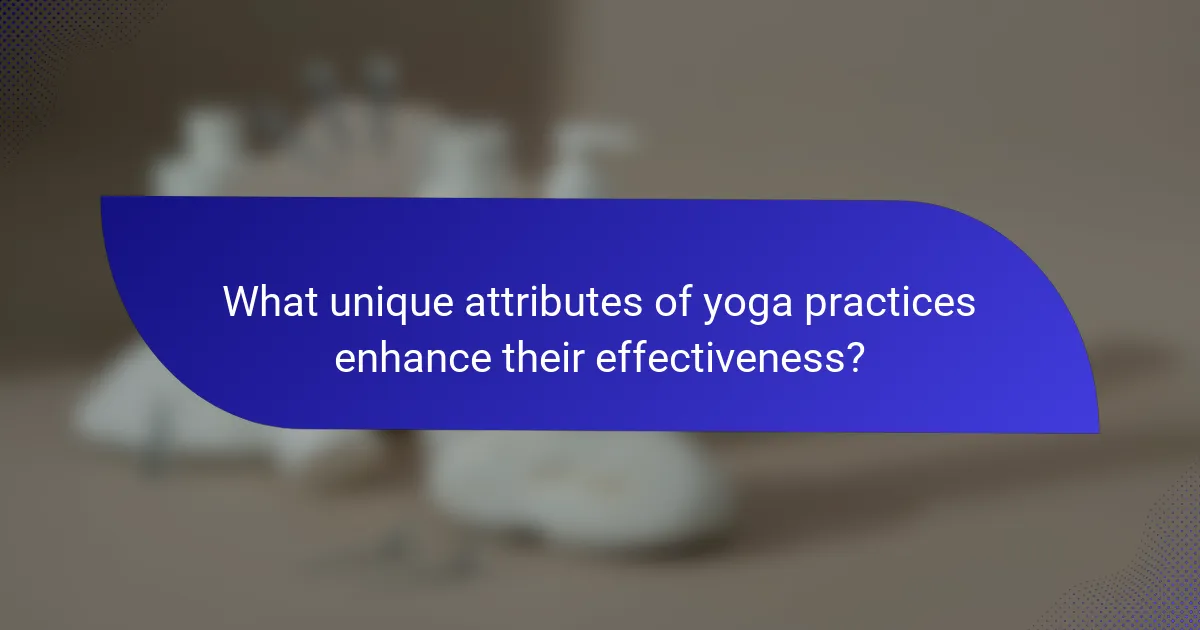
What unique attributes of yoga practices enhance their effectiveness?
Unique attributes of yoga practices enhance their effectiveness by promoting holistic well-being. Mindfulness in yoga deepens mental clarity, while various postures improve flexibility. Breathing techniques, or pranayama, reduce stress and foster relaxation. The integration of meditation cultivates emotional resilience, distinguishing yoga from other fitness routines. Additionally, community aspects in group classes provide social support, enhancing motivation and commitment.
How does the integration of props influence yoga’s benefits?
The integration of props enhances yoga’s benefits by providing support, improving alignment, and deepening stretches. Props like blocks, straps, and bolsters allow practitioners to achieve better postures, which can lead to increased flexibility and mental clarity. For instance, using a strap can help individuals reach deeper into stretches, promoting relaxation and reducing stress. Additionally, props can accommodate different body types and skill levels, making yoga more accessible and effective for everyone.
What cultural aspects of yoga contribute to its global appeal?
Yoga’s cultural aspects, such as mindfulness and community, enhance its global appeal. These elements foster a sense of belonging and promote mental clarity while reducing stress. The incorporation of ancient philosophies, like meditation and breath control, enriches the practice. Additionally, the adaptability of yoga styles caters to diverse preferences, making it accessible worldwide.
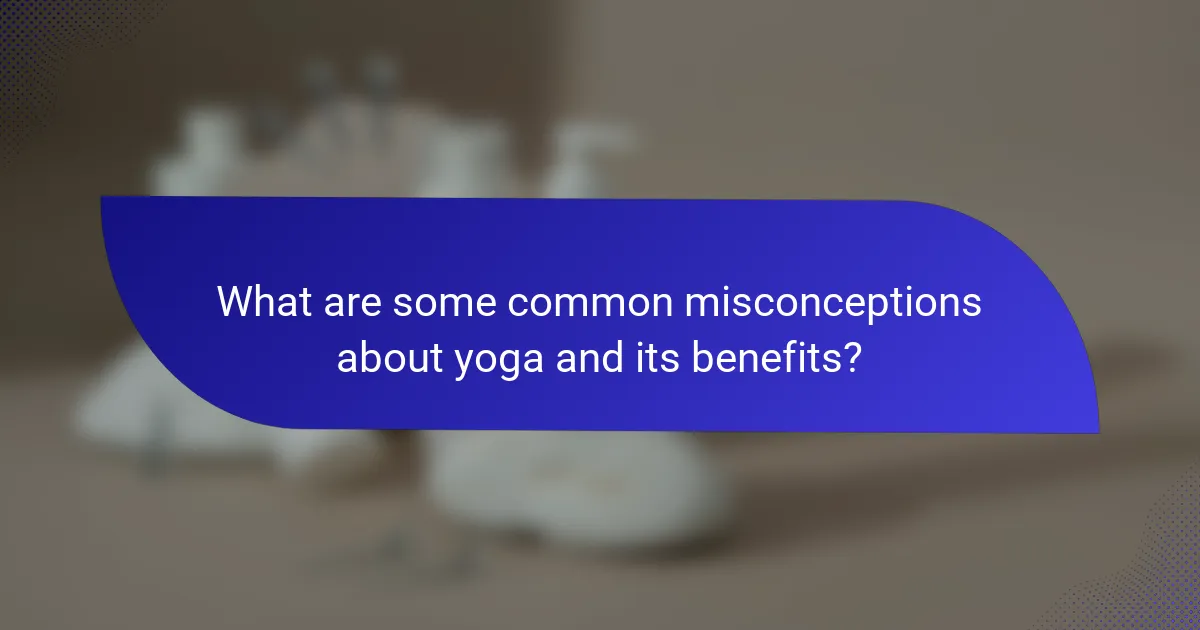
What are some common misconceptions about yoga and its benefits?
Many misconceptions about yoga include beliefs that it is only for flexibility or that it requires advanced skills. In reality, yoga practices promote stress relief, enhance mental clarity, and accommodate all skill levels. Some people think yoga is solely a physical exercise; however, it also nurtures emotional well-being through mindfulness and breath control. Additionally, many believe that yoga is not a workout, but studies show that it can improve strength and endurance. Misunderstanding the diversity of yoga styles leads to missed benefits, including relaxation and improved focus.
Why do some people believe yoga is only for the flexible?
Many believe yoga is only for the flexible due to misconceptions about its practices. This perception often stems from the emphasis on physical postures, which can create the impression that flexibility is a prerequisite. However, yoga is fundamentally about stress relief, mental clarity, and overall well-being, which can be accessed by individuals of all flexibility levels.
Yoga practices can be adapted to suit various body types and abilities, making it inclusive. Many styles focus on breathing techniques and meditation, which enhance mental clarity and reduce stress, regardless of physical flexibility.
As a result, the belief that yoga is only for the flexible limits its potential benefits for many. Emphasizing yoga’s adaptability encourages broader participation and highlights its role in promoting holistic health.
How can yoga be adapted for various fitness levels?
Yoga can be adapted for various fitness levels by modifying poses and sequences. Beginners may focus on foundational postures, while advanced practitioners can explore deeper variations. Props like blocks and straps enhance accessibility. Classes often offer modifications to ensure inclusivity. This adaptability allows individuals to experience stress relief, flexibility, and mental clarity regardless of their starting point.
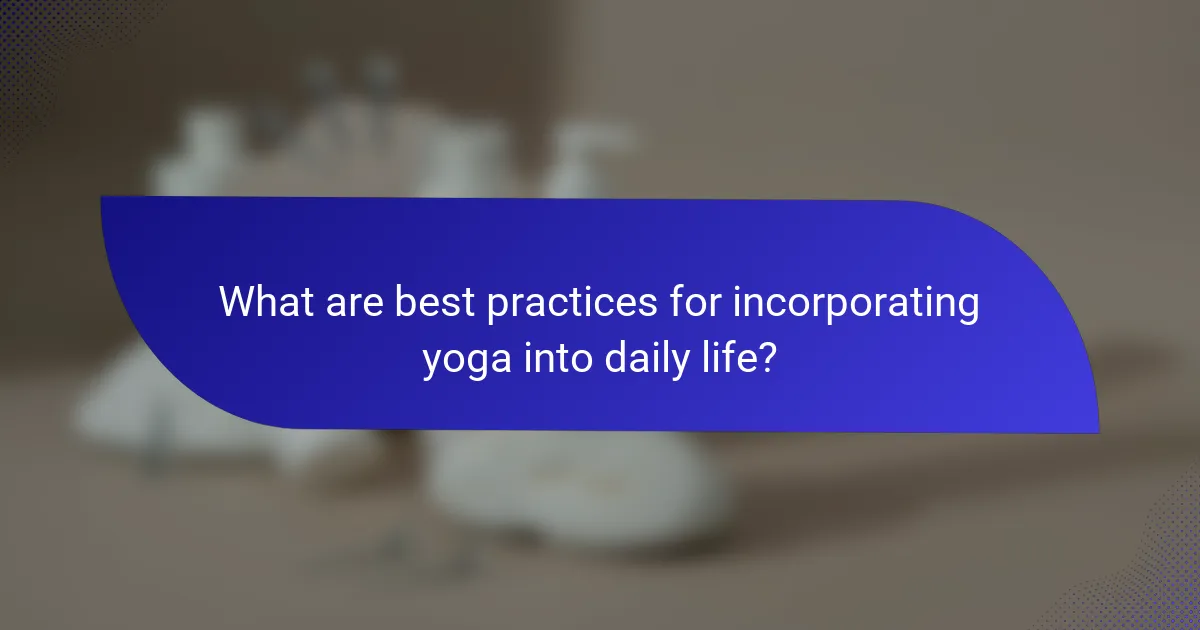
What are best practices for incorporating yoga into daily life?
Incorporating yoga into daily life enhances stress relief, flexibility, and mental clarity. Start with a consistent schedule, practicing for at least 15 minutes daily.
1. Set a specific time each day for yoga to build a routine.
2. Choose a quiet space free from distractions.
3. Focus on breath control to enhance relaxation and mindfulness.
4. Incorporate a variety of poses to improve flexibility and strength.
5. Use guided sessions or apps to maintain motivation and structure.
6. Reflect on your progress to reinforce positive mental clarity.
How can individuals create a sustainable yoga routine for stress relief?
Individuals can create a sustainable yoga routine for stress relief by establishing consistency, focusing on breath control, and incorporating a variety of poses. Start with short sessions, gradually increasing duration as comfort grows. Prioritise mindful breathing to enhance relaxation and mental clarity. Integrate restorative poses like Child’s Pose and Legs-Up-The-Wall for deep relaxation. Aim for at least three sessions per week to build a habit that effectively reduces stress. Consider journaling post-practice to reflect on emotional shifts and track progress.
What tips do experts recommend for maximizing the benefits of yoga?
To maximize the benefits of yoga, experts recommend consistency, proper alignment, and mindfulness during practice. Regular sessions enhance stress relief, flexibility, and mental clarity. Focus on breath control to deepen relaxation and concentration. Incorporate a variety of poses to target different muscle groups and maintain engagement. Lastly, listen to your body to avoid injury and promote a sustainable practice.
What common mistakes should beginners avoid in their yoga practice?
Beginners should avoid rushing into complex poses, neglecting breath control, and skipping warm-ups. These mistakes can hinder stress relief, flexibility, and mental clarity. Focus on foundational techniques to build a sustainable practice. Prioritise alignment to prevent injury and enhance benefits. Consistency over intensity fosters better results in yoga.